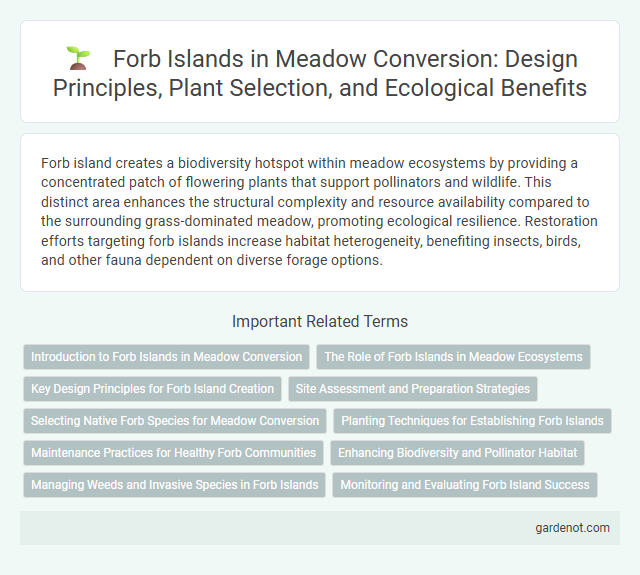Forb island creates a biodiversity hotspot within meadow ecosystems by providing a concentrated patch of flowering plants that support pollinators and wildlife. This distinct area enhances the structural complexity and resource availability compared to the surrounding grass-dominated meadow, promoting ecological resilience. Restoration efforts targeting forb islands increase habitat heterogeneity, benefiting insects, birds, and other fauna dependent on diverse forage options.
Introduction to Forb Islands in Meadow Conversion
Forb islands in meadow conversion are crucial for enhancing biodiversity by providing diverse habitats for pollinators and specialized flora. These islands consist primarily of herbaceous flowering plants, which improve soil health and support a balanced ecosystem within converted meadows. Incorporating forb islands increases ecological resilience and promotes sustainable land management practices.
The Role of Forb Islands in Meadow Ecosystems
Forb islands serve as critical biodiversity hotspots within meadow ecosystems by providing essential habitat and food resources for pollinators, herbivores, and soil microbes. Their dense and diverse plant structure enhances soil stability, nutrient cycling, and microclimate regulation, promoting overall meadow resilience. These islands also act as refugia for rare and endemic forb species, supporting ecological balance and facilitating species dispersal across the meadow landscape.
Key Design Principles for Forb Island Creation
Forb island creation prioritizes enhancing biodiversity by incorporating a diverse mix of native forb species to support pollinators and wildlife habitats. The design emphasizes soil health improvement, promoting organic matter accumulation and nutrient cycling to sustain plant growth. Strategic spatial arrangement ensures microhabitats that optimize light exposure, moisture retention, and reduce erosion.
Site Assessment and Preparation Strategies
Forb island site assessment involves detailed soil analysis, hydrology evaluation, and native species inventory to determine habitat suitability and restoration potential. Preparation strategies include invasive species removal, soil disturbance minimization, and tailored seed mix selection based on site-specific ecological conditions. Effective site assessment and preparation enhance forb island meadow conversion success by promoting native biodiversity and ecosystem resilience.
Selecting Native Forb Species for Meadow Conversion
Selecting native forb species for meadow conversion prioritizes biodiversity, ecosystem resilience, and habitat value. Focus on regionally adapted forbs such as Echinacea purpurea, Solidago canadensis, and Asclepias tuberosa, which support pollinators and improve soil health. Incorporating diverse native forbs enhances meadow establishment success and promotes long-term ecological balance.
Planting Techniques for Establishing Forb Islands
Forb islands are established through strategic planting techniques that enhance biodiversity and soil health in meadow conversions. Key methods include grouping native forb species with complementary root structures to improve nutrient uptake and microhabitat diversity. Utilizing plug plants and seed mixes tailored to local site conditions increases establishment success and resilience against invasive species.
Maintenance Practices for Healthy Forb Communities
Forb island maintenance requires selective mowing and targeted grazing to prevent invasive species dominance and promote diverse native forb regrowth. Prescribed burns during early spring help recycle nutrients and reduce woody plant encroachment, supporting a robust forb community. Regular soil monitoring ensures optimal moisture and nutrient availability, critical for sustaining forb island biodiversity and ecosystem resilience.
Enhancing Biodiversity and Pollinator Habitat
Forb islands significantly enhance biodiversity by providing diverse floral resources that support a wide range of pollinators, including bees, butterflies, and hoverflies. These habitat patches increase foraging opportunities and nesting sites, promoting pollinator population growth and ecosystem resilience. Incorporating forb islands in meadow conversion projects advances ecological connectivity and boosts overall habitat quality for sustainable pollination services.
Managing Weeds and Invasive Species in Forb Islands
Effective management of weeds and invasive species in Forb islands requires regular monitoring and targeted removal techniques to preserve native plant diversity. Utilizing manual removal, selective herbicides, and promoting competitive native forb growth can reduce invasive species encroachment. Implementing adaptive management plans and restoring soil health further supports long-term ecological balance in these sensitive meadow conversion areas.
Monitoring and Evaluating Forb Island Success
Monitoring and evaluating Forb Island success involves regular vegetation surveys to track species diversity and coverage changes over time, ensuring the establishment of target forb species such as wildflowers and native herbs. Soil quality assessments and pollinator activity measurements provide critical data on ecosystem health and habitat functionality. Utilizing remote sensing technologies and citizen science initiatives enhances data accuracy and engagement in long-term meadow restoration projects.
Forb island, Infographic

 gardenot.com
gardenot.com